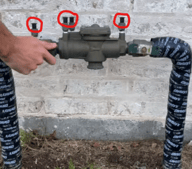As the winter season approaches, it becomes crucial to ensure that your irrigation system is properly winterized. Doing so is of utmost importance as it helps protect your system from freezing temperatures, preventing potential damage and costly repairs in the future.
When water freezes, it expands, which can lead to cracked or burst pipes in your irrigation system. When you winterize your system, you are draining all of the water from the pipes to avoid the frozen water expansion. By taking the time to winterize your system, you can avoid these issues and extend the lifespan of your equipment. So don't overlook the significance of winterizing your irrigation system – it's a small investment of time and effort that can save you from headaches and expenses down the line.
Winterizing Your Irrigation System Step by Step:
1. Turn the irrigation control panel (located in the garage) to the off position.
2. Turn off water to the irrigation system. To do this, locate your main water meter (usually in the front yard near the street). Your irrigation water valve will be nearby under a green lid. Turn the valve 90 degrees.
3. Locate your backflow device. This is an above-ground upside down 'U' pipe usually on the side of your home. Turn the valves 45 degrees.
4. Remove all caps/plugs from each test cock.

5. Locate straight bit screwdriver slot on the side of each test cock and turn them 90 degrees. This process will open the test cocks relieving all water pressure from the irrigation system. Leave the test cocks in the open position until you decide to start using your system again. Water should run out of the test cocks for only a couple of minutes. If water continues to run out of the test cocks, then the
irrigation cut off at the street is not fully closed.
6. It is also suggested to insulate the device in some manner. Insulated pouches are sold at most hardware stores. Zip tie to secure. This insulated pouch should stay on all winter long, until you are ready to use your sprinklers again in the spring.
Tips to protect indoor plumbing:
In extreme conditions (temperatures consistently below 30 degrees), it is also important to protect your indoor plumbing pipes. Take the following steps to protect your home and ensure you will still have warm water during freezing temperatures:
- Leave sinks that are against exterior walls on a slow drip
- Open under-sink cabinet doors to allow the heat to warm pipes
- Cover outdoor water bibs with styrofoam or insulated covers
- Place a space heater in the bathroom to keep the pipes warm and shower water flowing
** Freeze protection for both irrigation and plumbing are the responsibility of the homeowner and are considered homeowner maintenance
and are NOT covered under warranty.**


.jpg?width=1200&length=1200&name=Blue%20Modern%20Hello%20Winter%20Poster%20Landscape%20(2).jpg)

